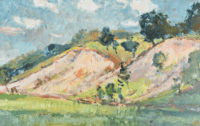Ludwig BOCK
Ludwig Bock was born on October 17, 1886, in Munich and passed away on August 14, 1971, in the same city. He was a German painter and graphic artist. Bock was the son of Heinrich Bock (1860–1927), a practicing physician, and his wife Anna, née Reitmayer. Born in Munich’s Brienner Straße, Bock’s talent was recognized by the artist Franz von Defregger, a patient of his father, who advised early artistic encouragement.
Initially, Bock specialized in landscapes and nature themes, influenced by his teachers. After traveling through Europe, he began exploring nudes and still lifes. In the subsequent years, he transitioned from a loose, impressionistically influenced naturalism to a highly expressive and contrasting use of color, aligning himself with the Expressionist movement. Beginning in 1927, Bock adopted a calmer artistic expression, focusing almost exclusively on still lifes, which in his later works drew inspiration from the style of the painter Carl Schuch.
His works were acquired by the Bayerischen Staatsgemäldesammlungen and the Städtische Galerie im Lenbachhaus in Munich and are also available in the art market. Bock was a member of the Reichsverband bildender Künstler (RvbK) and worked as a draughtsman and illustrator, including for a 1920 edition of Tyll Ulenspiegel by Charles de Coster published in Munich.
After attending elementary school, Bock went to the Maximiliansgymnasium in Munich in 1896, leaving after the 5th grade in June 1902. His first professional artistic training began at the private academy under Heinrich Knirr, followed by studies in the artists’ colony of Haimhausen with Bernhard Buttersack. In 1906, he was admitted to the Kunstakademie München, where he studied under the animal painter Heinrich von Zügel. Bock participated for the first time in the Munich Secession exhibition in 1908, receiving the bronze medal that same year and the silver medal in 1909. In 1910, he exhibited his works at the Thannhauser Gallery in Munich.
In 1913, he undertook a study trip to Paris to explore French modernism and painters such as Henri Matisse and Paul Cézanne, who greatly influenced his work. In 1917, he became a member of the Munich Secession and began participating regularly in exhibitions at the Glaspalast Munich and in various other German cities. In 1920, the Bayerischen Staatsgemäldesammlungen purchased his painting Nach dem Regen for the first time, followed by numerous additional acquisitions. In 1927, the Academy awarded him the title of Professor, and in 1929, he received the Rome Prize for the Villa Massimo.
Bock exhibited five works at the Great German Art Exhibition in Munich in 1937, 1940, and 1941, during which Hitler purchased the oil painting Erdbeeren, and the Städtische Galerie München acquired Pflaumenkörbchen in 1941.
After World War II, Bock participated in the reestablishment of the Munich Secession, which had been dissolved during the war, and he continued to exhibit regularly. In 1952, he received the promotion award for visual arts from the state capital Munich. Ludwig Bock passed away in Munich in 1971 at the age of 84. He was married twice, first to the painter Hansl Bock, and after their divorce around 1930, to Irene Bock.
Showing the single result
-
Landschaft mit Hangmuren | Gemälde von Ludwig BOCK
Ludwig BOCK (1886-1971)

